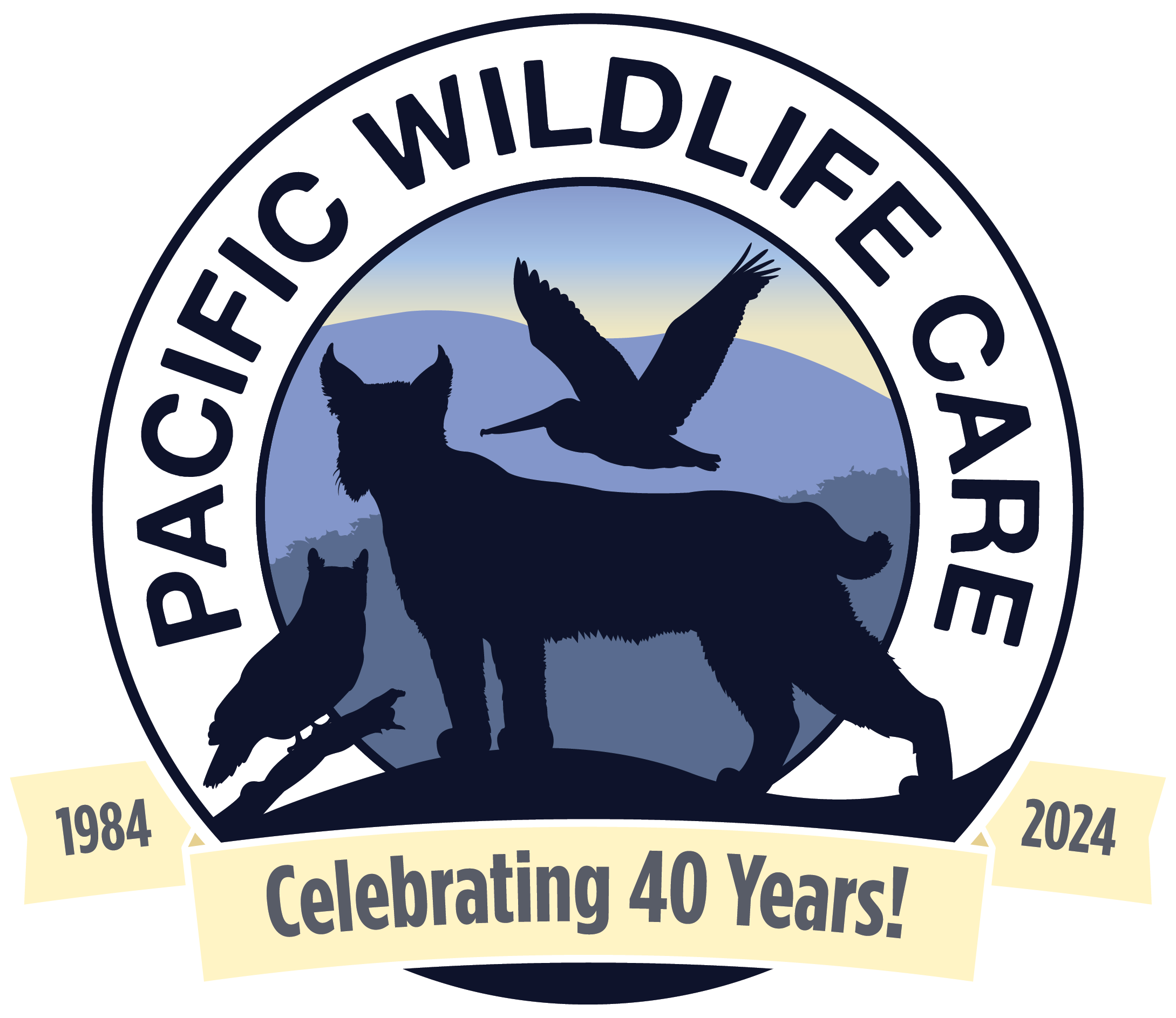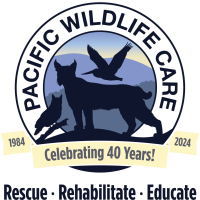Golden Eagle 24-1834: The Mystery and Challenges of a Very Large Bird
The story of Golden Eagle 24-1834 was a medical mystery full of clues, detective work, challenges, and one red herring.
When Rescue/Transport volunteer Piper Barnard got the call about a golden eagle on the ground, she and a friend staying with her rushed to Santa Margarita. They found the eagle in a “kind of populated area” on a hot day, with shade nowhere to be found. Folks had pulled over and were keeping an eye on the bird, who was apparently unable to fly but still able to hop awkwardly along the ground. The concern was that he could get away, into a place or position where capture wouldn’t be possible.

As sometimes happens during a rescue, Barnard was fortunate to be assisted in the capture by these concerned people. One produced a blanket and helped her contain and secure the bird until another Rescue/Transport team member, Laurie Edwards, could arrive with a large carrier and help Barnard hoist the huge bird safely into it for transport to the PWC clinic.
The cause of the eagle’s incapacity wasn’t immediately apparent, but there were the usual suspects. Could it have been electrocution, as happens too often with vultures, condors, and eagles (all with massive wing spans), as they land on unprotected power poles? Or lead poisoning, as happens with these same species and others as they scavenge on carrion shot with lead ammunition, now illegal in California? Or – with railroad tracks nearby – could he have been struck by a train or – since he was found near a street – by another vehicle?
At the clinic, the eagle’s intake examination by our staff and veterinarian – and subsequent clinical symptoms over the first few days in care – narrowed the suspect list. Electrocution and lead poisoning were ruled out. All signs suggested impact trauma. Among the bird’s issues were mild dehydration, feather lice, minor abrasions, and fresh blood in the oral cavity, but no fractures. The bird was also unsteady on his feet, possibly indicating trauma to his hind end. One might expect more extensive injuries if the impact had been with a train, so proximity to railroad tracks was a possible red herring.
Given intravenous fluids and medications, GOEA 24-1834 was left to rest in an enclosure inside the treatment room. The next morning, the eagle was “minimally responsive,” says Clinic Director Vann Masvidal, and didn’t “appear to have moved whatsoever overnight,” aside from a wad of regurgitated fur and medication found on the floor. Further examination revealed a dime-sized wound at the base of his tail. By that evening, although still not standing, the bird was alert and able to bite – hard.


Initially not eating on his own and not standing, over several weeks the bird improved. He progressed from being tube-fed to force-fed to hand-fed (accepting bites offered via hemostat) to the achievement of self-feeding – an occasion for both relief and excitement by staff. Within a week, he was standing consistently. Although he was “moderately ataxic [uncoordinated and wobbly] when trying to walk,” our veterinarian says he was “flapping around and causing a ruckus” in the enclosure.
And he was strong.
Handling this enormous bird was a challenge that “never got easier,” says Rehabilitation Technician Ellie Bedikian. It required strength, planning, and teamwork, as one person contained him while the other placed a hood over his head. Even with the hood on, he would try to bite. Bedikian has a deep admiration for this eagle, so powerful that “you felt the force of each flap” of a wing.
As the eagle recovered, he was becoming “more active and mobile” in the indoor enclosure, and Rehabilitation Technician Heather Baer says it was time to move him to a small aviary outside, where staff could better evaluate his balance and ability to get up to and land on perches. There, with more space for exercise, his body condition improved. His favored perch was usually the one over the door, and anyone entering with food or clean water for his bathing pool was immediately impressed with his massive presence looming above them.
In time, he graduated to an offsite, barn-size flight enclosure on the property of longtime PWC volunteer and educator Kelly Vandenheuvel. There, he was able to fly and improve his body condition. Several weeks later, a final evaluation determined he was BAR (bright, alert, and responsive), strong, and ready for release, which happened the next day in Santa Margarita, near where he had been found but at a safe distance from the populated area, train tracks, and roads.

A small cluster of onlookers gathered that day on a gentle slope as Vandenheuvel unzipped the carrier and pulled back the flap. Thrilled, they watched the magnificent golden eagle hop out, then take to the air and soar in a high arc off into the distance.
Epilogue: Several days later, rescuer Piper Barnard and her friend were recounting their experience with the eagle that first day. The friend mentioned a detail they had forgotten: one of the people at the scene had found a dead rabbit in the road, which he tossed aside into some bushes, so that a scavenger wouldn’t be attracted to it and be hit by a vehicle. A potential clue? Could that have been the source of the fur the eagle regurgitated that first night at the clinic? Could this predator, who likely survived in part from scavenging, have been struck by a vehicle while eating the rabbit? There’s no way to know. The mystery remains unsolved, but the ending is a good one, nevertheless.





